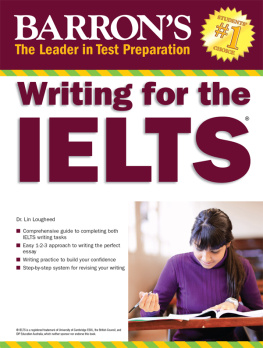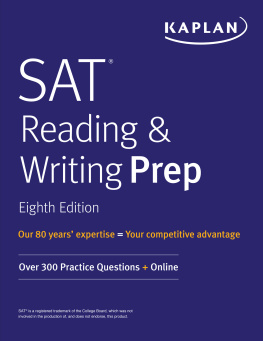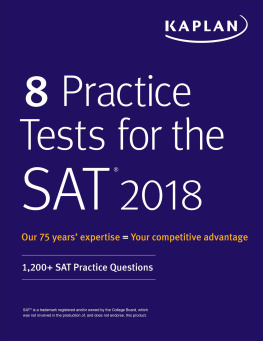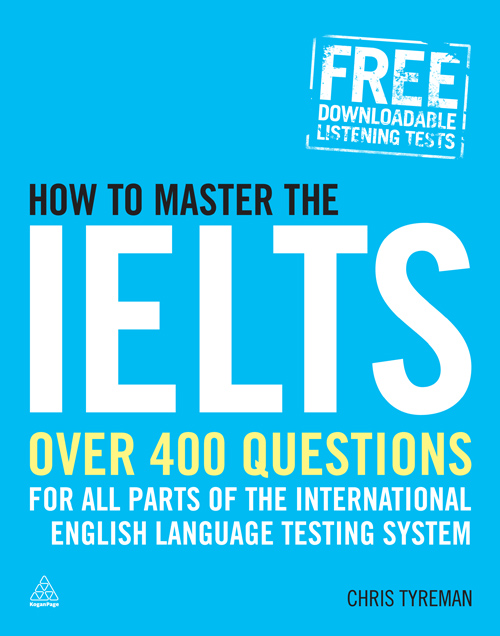Note on the Ebook Edition For an optimal reading experience, please view large
tables and figures in landscape mode. |
This ebook published in 2012 by
Kogan Page Limited
120 Pentonville Road
London N1 9JN
UK
www.koganpage.com
Chris Tyreman, 2012
E-ISBN 9780749459468
Contents
MP3 files for these tests can be downloaded for free at www.koganpage.com/editions/how-to-master-the-ielts/9780749456368 |
T he IELTS is the worlds most popular test with over 1.5 million people taking the test each year. It is intended for people who wish to study or work in an English-speaking country. You have the choice of two modules. The Academic module is for university degree course applicants. The General Training module is for people intending to migrate. This book contains four complete practice tests for the Academic module of the International English Testing Language System (IELTS) with additional tests for the General Training module. The tests provide IELTS candidates with plenty of realistic practice because they are similar in style and content to the University of Cambridge ESOL examinations.
Frequently Asked Questions (FAQs)
1. Where can I sit the IELTS?
You can sit the test in more than 130 countries at 800 test centres. Please visit the IELTS website at www.ielts.org to find a test centre near to you.
2. When can I sit the IELTS?
Tests are available every month of the year on fixed dates. There are 48 test dates for the Academic module and 24 test dates for the General module, but this does not mean that every centre offers a test on every date. The listening, reading and writing tests are taken on the same day. The speaking test may be on the same day as the other three tests or it can be up to seven days before or seven days after.
3. How do I register for the IELTS?
To register for the test you need to download a copy of the IELTS application form (PDF file) or ask your test centre for a copy. You need to return:
a completed and signed application form;
your fee for the test (payment by credit/debit card is widely accepted; some centres accept online payments and some accept a cheque/postal order);
a photocopy of your passport (or a photocopy of an EU National ID card);
two identical, colour, passport-size photos that are less than six months old, and without glasses being worn.
4. How much does it cost to sit the IELTS?
The fee for the IELTS varies from one country to another. As a guide, the fee for the tests (both Academic and General) was 115 in the UK in 2011. Some countries accept online applications and payments.
5. What do I need to take to the exam?
You must take the following:
a valid passport (or an EU National ID card), not a photocopy ;
at least two pens, two pencils, an eraser and a pencil sharpener (but no pencil case);
water to drink, in a transparent bottle.
If you sit the speaking test separately for example, the following week you must take your ID again. You must not take your mobile phone into the examination room.
6. When are my results available?
Normally online 13 days after your test date. The official Test Report Form will also be mailed to your address after this time.
7. How many times can I sit the test?
You can sit the test again as many times as you like and as soon as you like, but you have to sit all four sections of the test. You cannot retake just one module again, for example the speaking test.
8. How long is the result valid for?
Your IELTS score is valid for two years. You may have to sit the test again if your test result is more than two years old.
9. What band score do I need?
The IELTS is scored from 0 to 9. You need to check with your university or institution what band score they need. University degree course applicants should aim for a band score of 7.0 or higher. The band score for people who wish to work and live in another country is usually 5.0 or higher.
10. What is the test format?
The test is split into four sections that cover the four key English skills of listening, reading, writing and speaking. The breakdown of the questions within each of the four sections is as follows:
Listening Section (Academic and General modules) 40 questions
Four listening sections: 1, 2, 3 and 4, with 10 questions per section
Time allowed: 30 minutes.
Reading Section (Academic module) 40 questions
Three reading passages: 1, 2 and 3, with 40 questions in total (eg 13, 13, 14)
Time allowed: 60 minutes.
Writing Section (Academic module) 2 tasks
Task 1 (at least 150 words); eg describe the information in a graph or chart
Task 2 (at least 250 words); eg argumentative topic; reasons for and against
Time allowed: 60 minutes (eg 20 minutes on Task 1 and 40 minutes on Task 2).
Reading Section (General Training module) 40 questions
Section 1: Two short texts of factual information; eg English in a social setting
Section 2: Two short texts of factual information; eg English in a work context
Section 3: One longer passage of text of general interest
Time allowed: 60 minutes.
Writing Section (General Training module) 2 tasks
Task 1 (at least 150 words); eg write a letter on the chosen topic
Task 2 (at least 250 words); eg argumentative topic; reasons for and against
Time allowed: 60 minutes (eg 20 minutes on Task 1 and 40 minutes on Task 2).
Speaking Section (Academic and General modules) 3 parts
Part 1: Familiar topics; Part 2: Brief talk; Part 3: Discussion
Time allowed: 11 to 14 minutes.
Book format
The questions in this book are numbered from 1 to 400 to make every answer easy to find. The main Answer section is found at the end of the book before the Appendices. There are two appendices: Appendix 1 is the Reading section vocabulary; Appendix 2 lists British and American spellings. The IELTS practice tests in this book are set out as follows:
Test 1: Questions 1 to 80; Test 2: Questions 81 to 160; Test 3: Questions 161 to 240; Test 4: Questions 241 to 320
General Training Reading and Writing Test A: Questions 321 to 360
General Training Reading and Writing Test B: Questions 361 to 400
Listening Test instructions
MP3 files for these tests can be downloaded for free at www.koganpage.com/editions/how-to-master-the-ielts/9780749456368
The IELTS practice tests in this book start with the Listening Test as does the actual test. Your CD player or computer must be able to play MP3 files. There are 16 separate recordings four for each practice test. Section 1 is conversation between two people. Section 2 is a talk given by one person (monologue). Section 3 is a conversation between two or more people and Section 4 is another monologue. If you want to know more about what to expect then turn to the audio-scripts at the end of the book. Note that the answers to the listening tests have been underlined in the audio-scripts.
You will be allowed approximately 30 seconds to study the questions before the test begins. Use this time to check what types of answers are needed (for example, dates, times, names, money, etc), and pay special attention to the first question. Several sentences of dialogue may take place before you hear the words needed to answer the first question. If you miss the start point and fail to answer the first question you will not be ready to answer the second question. You will hear the recording only once , so if you think you have missed an answer you must move on to the next question. If you look at the audio-scripts you will see that each script is split into two parts separated by a dashed line; there is a 30-second gap at this point (first three scripts). Use these 30 seconds to read the next 10 questions. You will be given a piece of paper on which to write your answers. At the end of the listening module you will have 10 minutes to transfer your answers to the answer sheet. Finally, be aware that the Listening Test tests three skills of English language. You need to listen to the dialogue, read the questions and write the answers. Marks are needlessly lost when the candidate fails to read the instructions, or transfers them incorrectly to the answer sheet.













